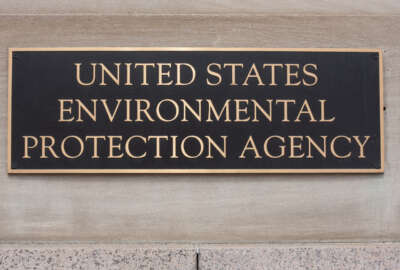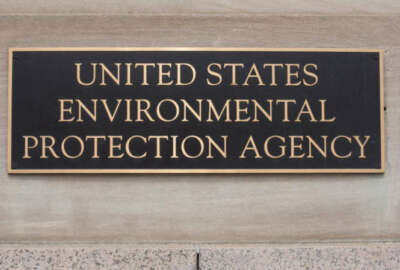
EPA may offer more buyouts, early retirement, depending on funding from Congress
The Environmental Protection Agency may offer more buyouts and early retirements to its workforce later this year, once Congress approves a federal spending plan.
Subscribe to Federal Drive’s daily audio interviews on iTunes or PodcastOne.
The Environmental Protection Agency may offer more buyouts and early retirements to its workforce later this year, once Congress approves a federal spending plan.
In the first year of the Trump administration, the EPA made Voluntary Separation Incentive Payment (VSIP) and Voluntary Early Retirement Authority (VERA) offers to several thousand employees, but only about 400 employees left under these conditions.
However, the agency may receive another pool of money for separation incentives once Congress approves a comprehensive budget for the rest of fiscal 2018.
Under the latest draft of its fiscal 2018 spending plan, the Senate Appropriation Committee has set aside more than $79 million for the EPA’s operations and administration budget, which includes more funding for VERA/VSIP incentives.
“The bill concurs with the Agency’s proposed allocation of resources for workforce reshaping through buyouts and voluntary separation agreements offered to employees,” a committee document stated.
Doing the rough math, John O’Grady, president of the American Federation of Government Employees (AFGE) Council 238, which specifically represents EPA employees, said the EPA could offer buyouts to an additional 2,200 to 2,500 employees. The maximum buyout a civilian federal employee can receive under current law is $25,000.
“I think we will see another round of buyouts with that kind of money in play,” O’Grady said in an interview with Federal News Radio.
The last round of buyouts and early retirements took place last summer, when the EPA offered buyouts to 1,227 employees and offered early retirement to 3,654 employees. EPA employees who took the buyouts or retired early had to separate from the agency by September 2017.
According to a May 2017 internal memo previously obtained by Federal News Radio, the EPA had set aside $12 million for last summer’s VERA/VSIP incentive payments.
In 2014, the EPA received $16.2 million for another round of buyouts, and 456 workers accepted.
The threat of further workforce reductions comes at a time when the EPA has already reached a historic milestone in shedding employees. O’Grady said the agency currently has about 14,140 full-time equivalent employees, the lowest headcount since Ronald Reagan’s presidency.
What’s more, the EPA’s workforce is getting older. This year, 23 percent of the agency’s employees have reached retirement age, O’Grady said. In three years, more than 45 percent of EPA employees will be eligible for retirement.
“I believe the goal is to drain the agency, and the problem with that is the people that will be leaving and the people that have left are the ones with the most experience and know the programs and were not transferring that knowledge to the next generation of EPA workers,” he said.
The agency’s headcount has slowly declined over several administrations. When President Barack Obama came into office in 2009, the EPA had a workforce of around 17,000 employees. By the time Obama left the White House in 2017, the agency employed fewer than 15,000 workers. The EPA reached a high point in fiscal 1999, under the Clinton administration, when it had about 18,100 employees.
Since President Donald Trump took office, about 700 employees have left the EPA — about 400 under the VERA/VSIP offers, plus an additional 300 employees who have retired under standard conditions.
“This would be losses not just through the buyouts, but also through just normal retirements. And I think there might be some retirements where people are just kind of fed up,” O’Grady said, who added that recent retirement levels at the EPA have been “par for the course,” but may rise if more buyouts are offered.
The House and Senate still need to approve a federal spending plan for the rest of fiscal 2018, and could wind up compromising on less funding for EPA buyouts. The current continuing resolution expires at midnight on Jan. 19.
The House’s 2018 spending bill sets aside a $7.5 billion budget for the EPA, about $534 million below fiscal 2017 enacted levels, while the Senate draft gives the agency a $7.9 billion budget. The House spending plan matches the EPA’s fiscal 2006 budget.
Wherever they meet in the middle on appropriations, O’Grady said the funding won’t meet the EPA’s needs.
“We are down to the point right now where we cannot accomplish the mission of the agency,” he said.
Since 65 percent of the EPA’s budget gets passed on to states and municipalities, O’Grady said reductions at the federal level can cause a ripple effect across the country.
“When you cut the EPA’s budget, you cut the money that’s going to the states,” O’Grady said. “They don’t have the money, they don’t have the staffing to take any more responsibilities on. So this idea that we’re going to transfer the federal workload over to the states is just not going to work.”
The EPA on Monday did not immediately respond to requests for comment.
Copyright © 2025 Federal News Network. All rights reserved. This website is not intended for users located within the European Economic Area.
Jory Heckman is a reporter at Federal News Network covering U.S. Postal Service, IRS, big data and technology issues.
Follow @jheckmanWFED





